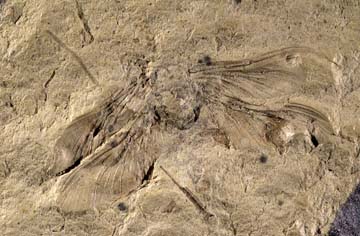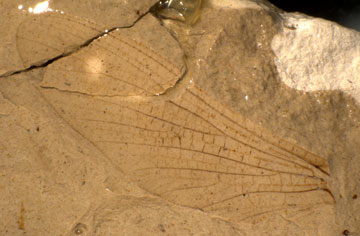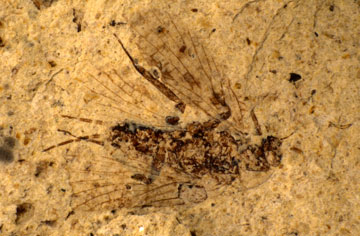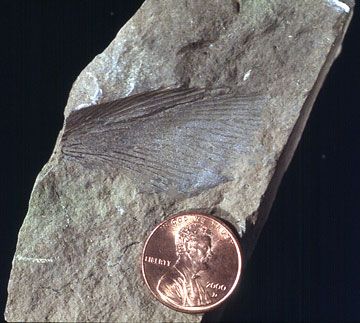Insects
Insects were the first animals on Earth to develop flight, which is probably one reason they've been so successful. In sheer numbers, insects dominate the animal kingdom, with more than 750,000 living species described. This is more than all the other living animal species combined, and scientists estimate that there are perhaps at least a million more insect species that have not yet been described.

Insects were probably similarly abundant in the past, but the fossil record of insects is limited, with only about 7,000 species known. The scarcity of insect fossils (compared to their present, and probable past, diversity) is a consequence of their relative fragility, lack of hard parts, and the fact that they lived on land. Rapid burial is essential for preservation, and this is more likely to happen in and around water than on land.

The oldest fossil insects are primitive, wingless insects (similar to modern silverfish and springtails) that lived during the early part of the Middle Devonian Period, roughly 395 million years ago. These primitive insects are known only from a few fragmentary specimens found in rocks from Scotland, New York, and Quebec. Nonetheless, these fragments have led experts to agree that insects must have originated millions of years earlier, perhaps at the end of the Silurian Period, about 419 million years ago.
The first substantial record of insects is in Pennsylvanian rocks, deposited from about 323 to 299 million years ago, by which time insects had evolved wings and a variety of other specialized structures. Between the scarce Devonian fossils of primitive forms and the abundant and diverse Pennsylvanian fossils, there is a huge gap in the fossil record. So far, no fossil insects are known from Mississippian rocks, most of which were deposited in marine environments. Thus, both the origin of insects and the evolution of wings remains a mystery.

Insects are arthropods (arthro means jointed and pod means foot). Like other arthropods—shrimps, lobsters, crabs, spiders, scorpions, and the extinct trilobites—insects have a hardened outer covering, or exoskeleton, and jointed appendages used for feeding and movement.
Insect wings contain a network of veins that serve as blood vessels and aid respiration. Because the wings resist deterioration better than the rest of the body, they are the part most commonly fossilized. Despite their delicate appearance, insect wings hold up better to compression than the rest of the body, and the wing is strengthened by its network of veins. In addition, predators prefer the body to the wings, another reason why about half of all described species of fossil insects are known from their wings alone.

Although fossil insects aren't common in most Kansas rocks, the state is home to the Elmo fossil site, one of the world's richest sources of Permian insects, those that lived from 299 to 252 million years ago. Located near the town of Elmo, south of Abilene in Dickinson County, the fossil site has yielded thousands of well-preserved specimens.
During Permian times, the Elmo site was a swampy, forested lowland around a freshwater lake, an oasis in an otherwise arid landscape. This ancient environment accounts for the excellent preservation of the Elmo fossils: insects probably became mired in the muddy swamp and were quickly buried by fine-grained sediments before they could be consumed by scavengers or microbes.
Among the numerous specimens recovered from the Elmo site was a giant dragonfly-like insect, Meganeuropsis permiana. With a wingspan of 29 inches, Meganeuropsis is the largest insect ever known and must have been a formidable predator. By the end of Permian Period, however, Meganeuropsis and many other Permian insects, became extinct in the world's largest mass extinction, a catastrophe that killed off roughly 90 percent of all living creatures.
Fossil insects have also been found in the Pennsylvanian and other Permian rocks of eastern Kansas, most notably the Hamilton quarry, another famous fossil site, in Greenwood County. The 295-million-year-old limestones at the Hamilton quarry include fossils of dragonflies, crickets, and cockroaches.
Stratigraphic Range: Lower Pennsylvanian to Holocene.
Taxonomic Classification: Insects belong to the Kingdom Animalia, Phylum Arthropoda, Superclass Hexapoda, Class Insecta. Insects that cannot fold their wings next to the body when at rest are grouped into the Subclass Palaeoptera, while those that can fold their wings against their body are assigned to the Subclass Neoptera.
Text and photos from Windows to the Past: A Guidebook to Common Invertebrate Fossils of Kansas, Kansas Geological Survey Educational Series 16.
Sources
Boardman, R. S., Cheetham, A. H., and Rowell, A. J., eds., Fossil Invertebrates: Boston, Blackwell Scientific Publications, 713 p.
Brosius, L., 1995, The Collector, Earth, v. 4, pt. 1, p. 50-57.
Carpenter, F. M., 1992, Systematic Descriptions of the superclass Hexapoda; in, Treatise on Invertebrate Paleontology, Arthropoda 4—Superclass Hexapoda, Part R, v. 3-4, R. L. Kaesler, ed.: Boulder, Colorado, and Lawrence, Kansas, Geological Society of America and The University of Kansas, p. 1-655.
Clarkson, E. N. K., 1979, Invertebrate Palaeontology and Evolution, 3rd Edition: London, Chapman and Hall, 434 p.
Doyle, P., 1996, Understanding Fossils—An Introduction to Invertebrate Paleontology: Chichester, Wiley, 409 p.